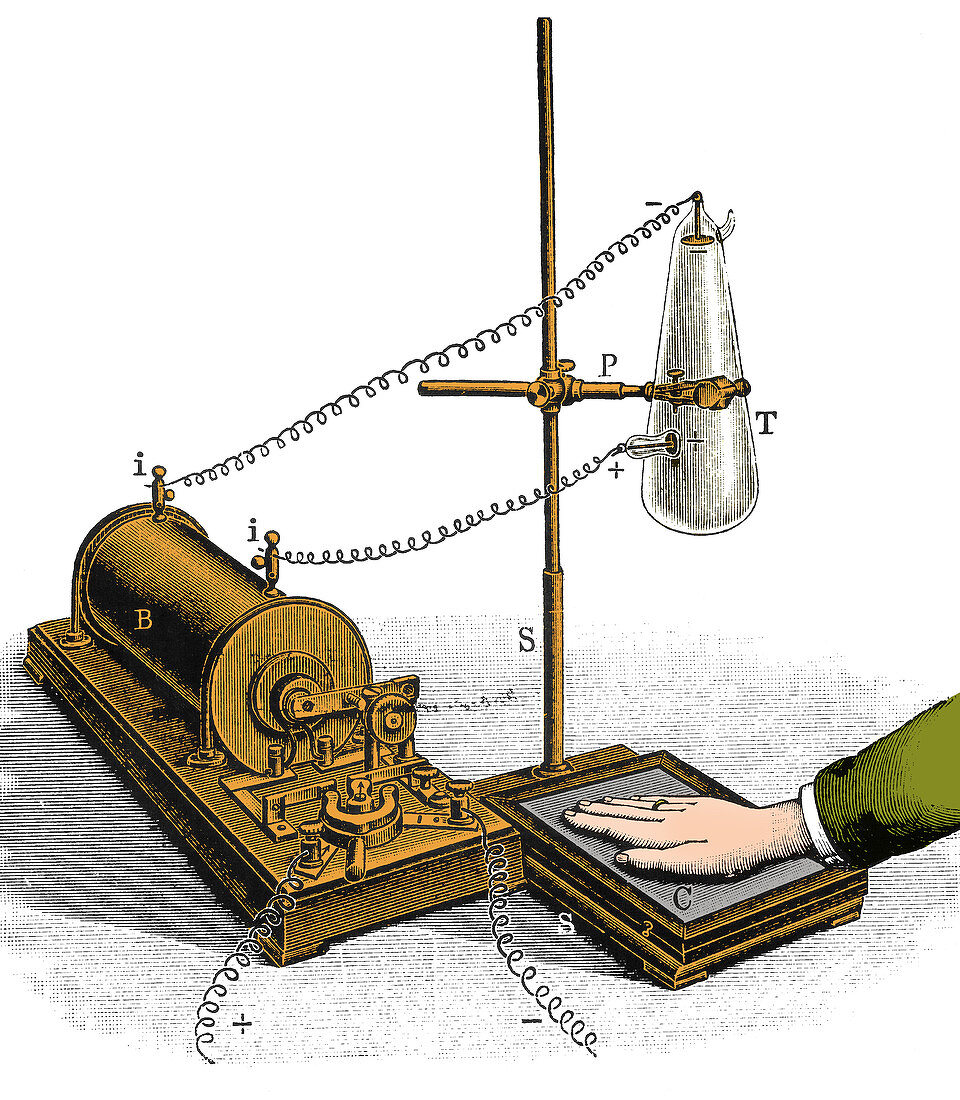Roentgen's X-Ray Machine, 19th Century
Bildnummer 12631405

| Wilhelm Conrad Roentgen (1845-1923), German experimental physicist and discoverer of X-rays. While using a discharge tube (in which an electric discharge is passed through a gas at low pressure) in a darkened room, Roentgen noticed that a card coated with barium platinocyanide glowed when the tube was switched on. The effect was not blocked by an intervening wall, or even a thin sheet of metal. Roentgen termed this newly discovered phenomenon X-ray radiation, and suggested that it consisted of electromagnetic rays with a shorter wavelength than light. He was awarded the first Nobel Prize for Physics in 1901. Drawing of the X-ray machine used by German physicist Wilhelm Roentgen to produce images of the hand. The generator (B) supplied a high voltage to the cathode ray tube (Crookes tube) at upper right (T). This tube produced X-rays which left an image of the hand on a covered, photographic plate (C). | |
| Lizenzart: | Lizenzpflichtig |
| Credit: | Science Photo Library / Science Source |
| Bildgröße: | 3082 px × 3531 px |
| Modell-Rechte: | nicht erforderlich |
| Eigentums-Rechte: | nicht erforderlich |
| Restrictions: | - |
Preise für dieses Bild ab 15 €
Universitäten & Organisationen
(Informationsmaterial Digital, Informationsmaterial Print, Lehrmaterial Digital etc.)
ab 15 €
Redaktionell
(Bücher, Bücher: Sach- und Fachliteratur, Digitale Medien (redaktionell) etc.)
ab 30 €
Werbung
(Anzeigen, Aussenwerbung, Digitale Medien, Fernsehwerbung, Karten, Werbemittel, Zeitschriften etc.)
ab 55 €
Handelsprodukte
(bedruckte Textilie, Kalender, Postkarte, Grußkarte, Verpackung etc.)
ab 75 €
Pauschalpreise
Rechtepakete für die unbeschränkte Bildnutzung in Print oder Online
ab 495 €
Keywords
- 19. Jahrhundert,
- 20. Jahrhundert,
- angesehen,
- Ausrüstung,
- berühmt,
- Deutsche,
- Diagnose,
- Diagnosetest,
- eingefärbt,
- elektromagnetisch,
- elektromagnetische Strahlung,
- entdeckt,
- Entdeckung,
- erst,
- Erweiterung,
- europäisch,
- Experiment,
- Feststellung,
- Gerät,
- Geschichte,
- Gravur,
- Historisch,
- Illustration,
- Instrument,
- Kunst,
- Kunstwerk,
- Maschine,
- medizinisch,
- medizinische Bildgebung,
- medizinische Prozedur,
- Physik,
- Physiker,
- Professor,
- Radiographie,
- Radiologie,
- Röntgen,
- sehr bekannt,
- Wellenlänge,
- Werkzeug,
- wichtig,
- Wissenschaftler,
- Zeichnung
